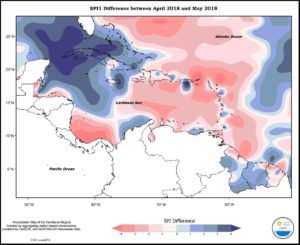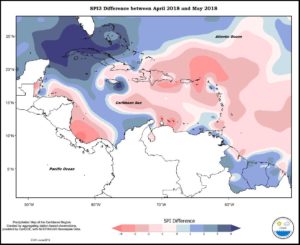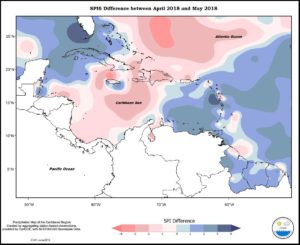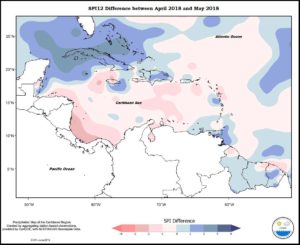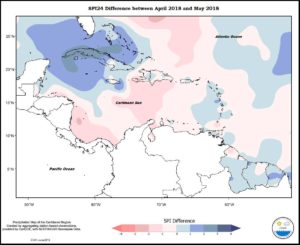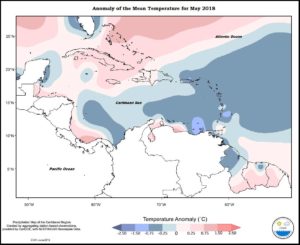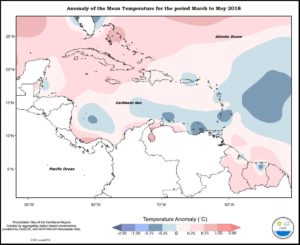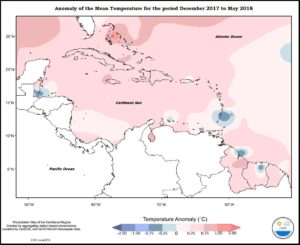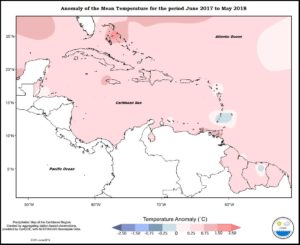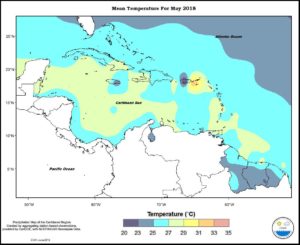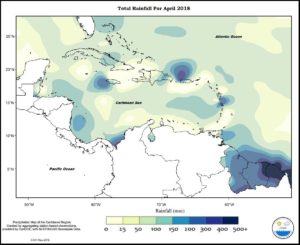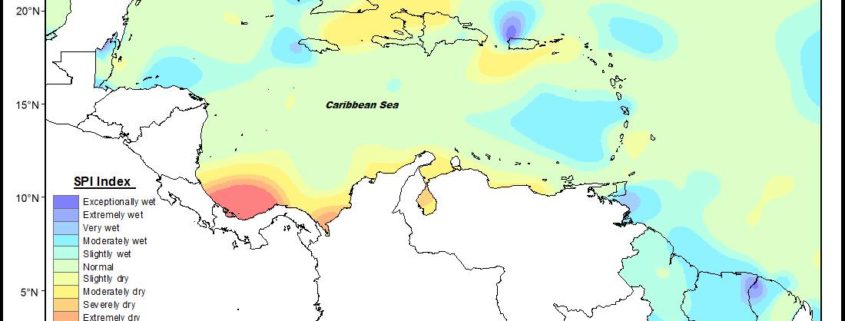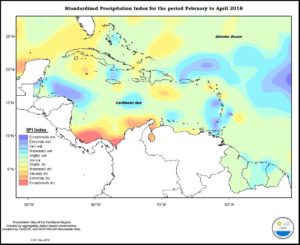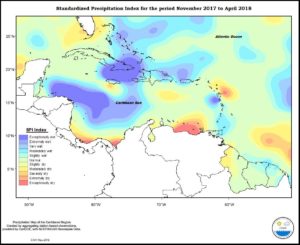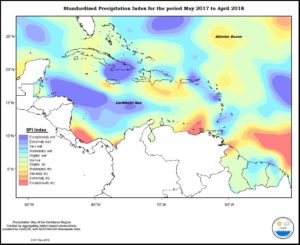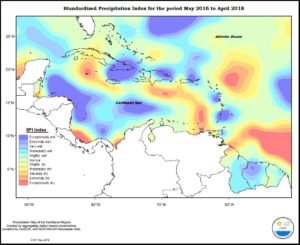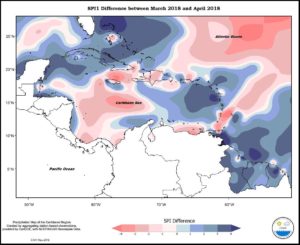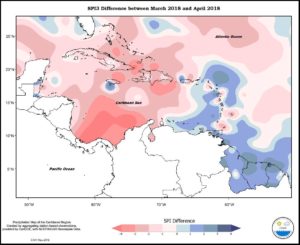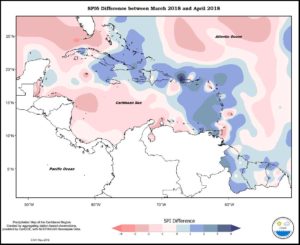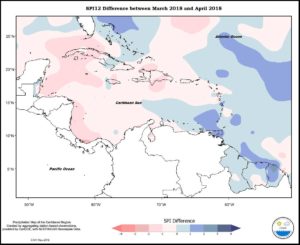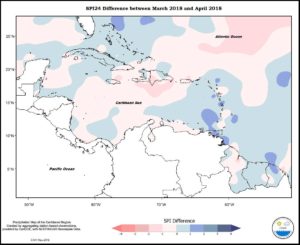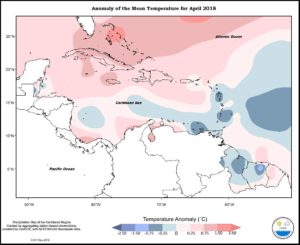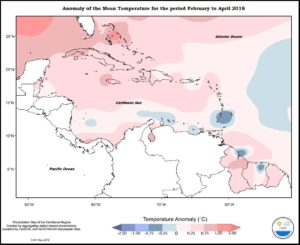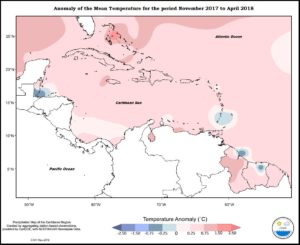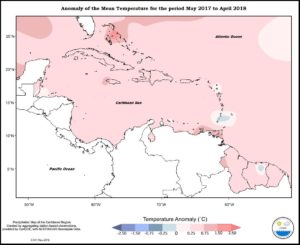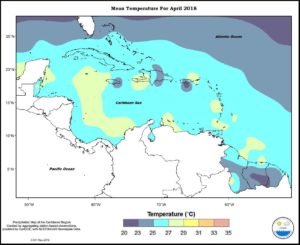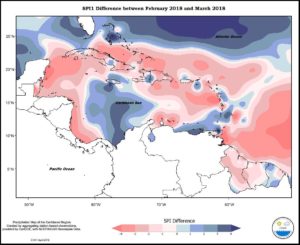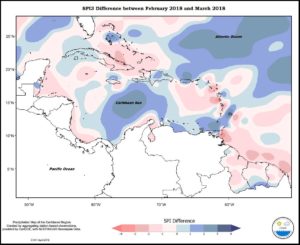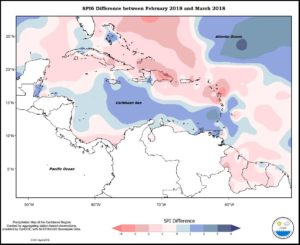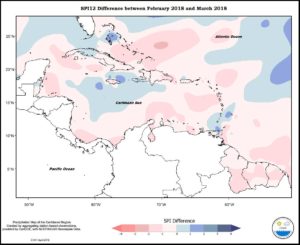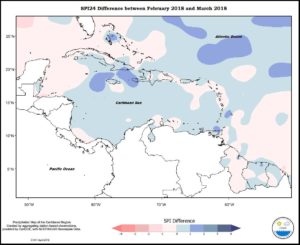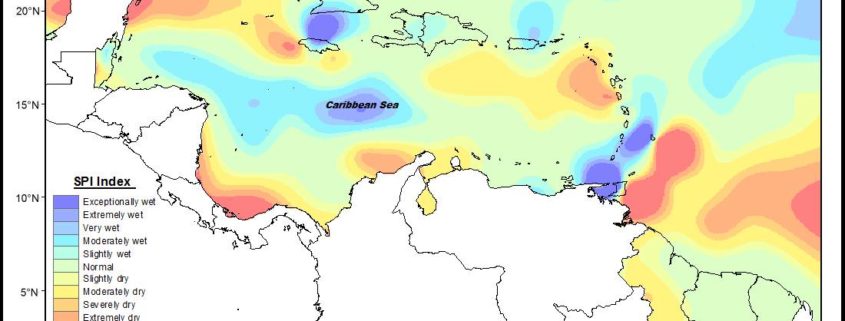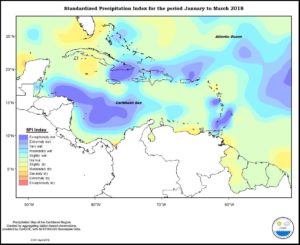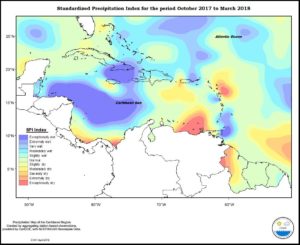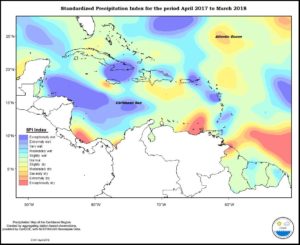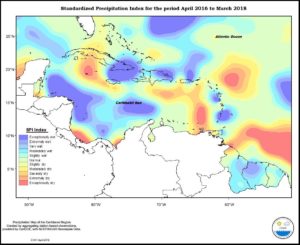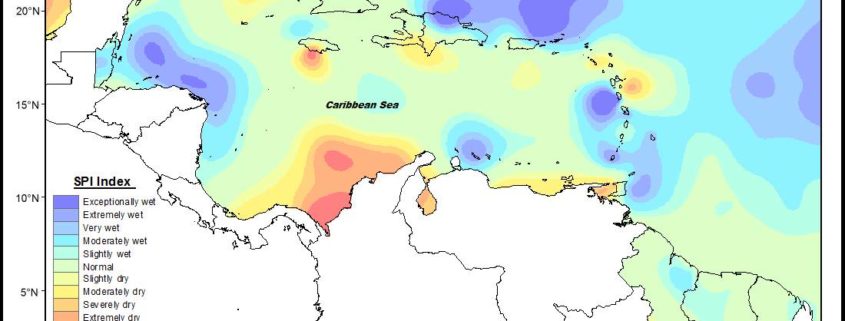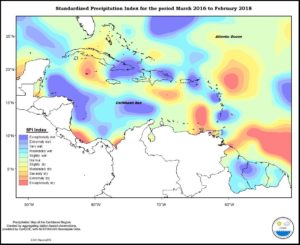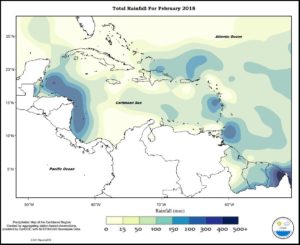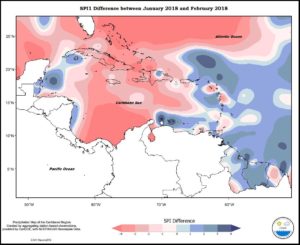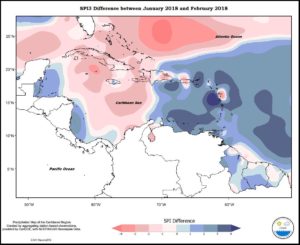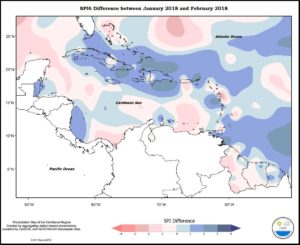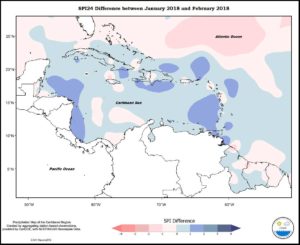SPI Monitor April 2018
/in SPI Monitor /by SherikaApril 2018
Rainfall in the islands of the eastern Caribbean was predominantly normal to above. Trinidad was normal to moderately wet from north to south; Tobago, Grenada, and Dominica normal to slightly wet; Barbados, St. Vincent, St. Lucia, Guadeloupe, Antigua, St. Kitts, Anguilla and St. Maarten normal; and Martinique moderate to very wet. Conditions in the Guianas ranged from normal in eastern French Guiana and north-central Guyana to very wet in southern Guyana and to exceptionally wet at the northern border of Suriname and French Guiana. Curacao was normal. Puerto Rico ranged from exceptionally wet in the northeast to normal in the east, while conditions in Hispaniola ranged from slightly wet in the southeast to moderately dry in the north. Conditions in Jamaica ranged from moderately wet in the west to slightly dry in the east, but Grand Cayman was normal. Cuba ranged from very wet in east central areas to normal in the west and moderately dry in the east. Northern Bahamas ranged from slight to extremely wet, while Belize ranged from normal in central areas to extremely wet in the north and moderately wet in the south.
February to April 2018
For the three month period, the islands of the eastern Caribbean experienced mixed rainfall conditions. Trinidad and Barbados was normal to very wet; Tobago normal to slightly wet; Grenada very to extremely wet; St. Vincent normal to moderately wet; St. Lucia, Anguilla and St. Maarten normal; Martinique moderately wet; Dominica normal to very wet; Guadeloupe normal to slightly dry; Antigua slightly dry; and St. Kitts moderately dry. Conditions in the Guianas ranged from normal over most of Guyana and French Guiana to very wet at the northern Suriname/French Guiana border. Curacao was moderately wet. Conditions in Puerto Rico ranged from very wet in the west to slightly wet in the east, but Hispaniola though predominantly normal, experienced slight to moderate wetness in northern Dominican Republic and slightly dry conditions in the south of the island and northwest Haiti. Jamaica ranged from normal to moderately wet from south to north, but Grand Cayman was moderately dry. Western Cuba was normal to moderately dry, while eastern Cuba was normal to moderately wet. Conditions in northern Bahamas ranged from moderately dry to moderately wet, but Belize ranged from normal near central areas to extremely wet in the north and moderately wet in the south.
November 2017 to April 2018
There was a distinction in rainfall totals between the northern and southern islands of the eastern Caribbean for the six month period. Trinidad, Tobago and Grenada were moderately wet; Barbados, Anguilla and St. Maarten normal; St. Lucia normal to slightly wet; Martinique normal to moderately wet; Dominica moderate to exceptionally wet; Guadeloupe moderately wet to severely dry; Antigua moderately dry; and St. Kitts slightly dry. Conditions in the Guianas ranged from moderately dry in western Guyana to moderately wet at the northern Suriname/French Guiana border and northern French Guiana. Curacao was normal. Conditions in Puerto Rico ranged from extremely wet in the west to moderately wet in the east; and in Hispaniola ranged from normal in the south to extremely wet in the northeast and northwest. In Jamaica, conditions ranged from moderately dry in the south to exceptionally wet in the north, but Grand Cayman was normal. Rainfall in western Cuba was normal, but the east was slight to exceptionally wet, while northern Bahamas ranged from moderately dry to very wet. Belize was predominantly normal to slightly wet.
May 2017 to April 2018
Normal to above normal rainfall totals were experienced in the islands of the eastern Caribbean for the twelve month period. Trinidad was moderate to exceptionally wet; Tobago normal to moderately wet; Grenada extremely wet; Barbados very wet; St. Lucia and Martinique normal to slightly wet; Dominica very to extremely wet; Guadeloupe slight to very wet; Antigua and Anguilla normal; and St. Kitts moderately wet. Conditions in the Guianas were predominantly normal to moderately wet, apart from in northern Guyana where it was slight to extremely dry, and to extremely wet at the Suriname/French Guiana border. Curacao was normal. Conditions in Puerto Rico ranged from severely dry in the west to extremely wet in the east, while Hispaniola ranged from moderately dry in the south to moderately wet in the extreme western Haiti and very wet in northern Dominican Republic. Conditions in Jamaica ranged from moderately dry in the south to exceptionally wet in the north, while Grand Cayman was slightly dry. Western Cuba was slightly wet to slight dry, while the eastern half was normal to exceptionally wet. Northern Bahamas was normal to slightly wet, but Belize was normal in central areas to moderately wet to the north and south.
May 2016 to April 2018
Disclaimer
The information contained herein is provided with the understanding that The Caribbean Institute for Meteorology and Hydrology makes no warranties, either expressed or implied, concerning the accuracy, completeness, reliability, or suitability of the Outlook. The information may be used freely by the public with appropriate acknowledgement of its source, but shall not be modified in content and then presented as original material.
Mean Temperature Anomalies April 2018
/in Climate Monitoring, Mean Temperature Anomalies /by Wayne DepradineSPI Monitor March 2018
/in SPI Monitor /by SherikaMarch 2018
Mixed conditions were experienced in the islands of the eastern Caribbean for the month of February, being particularly different between the south and north. Apart from in the extreme southeast that had below normal rainfall, in Trinidad was normal to exceptionally wet; Tobago and Guadeloupe normal to slightly dry; Grenada very wet; Barbados from slightly dry in the southeast to exceptionally wet in the west; St. Vincent moderate to very wet; St. Lucia and St. Croix normal; Martinique normal to slightly wet; Dominica moderate to severely dry; Antigua slightly dry; St. Kitts severe to extremely dry; and St. Maarten moderately dry. Rainfall in the Guianas was predominantly normal, particularly in Suriname and French Guiana, but ranged from severely dry in the extreme west of Guyana to normal in the east. Aruba was moderately dry and Curacao slightly dry. Puerto Rico ranged from normal in the west to moderately wet in the east, while Hispaniola was normal to slightly wet. Conditions in Jamaica ranged from moderately dry in the extreme west and east to exceptionally wet in the north, but Grand Cayman was moderately dry. Conditions in Cuba ranged from moderately dry in the west to very wet in the extreme south; but northern Bahamas was extremely dry to extremely wet. Belize ranged from severely dry in the west to moderately wet in the north.
January to March 2018
For the three month period, contrasting conditions between the south and north were experienced in the islands of the eastern Caribbean. Trinidad ranged from normal in the south to very wet in the northwest; Tobago moderate to very wet; Grenada exceptionally wet; Barbados moderate to exceptionally wet from southeast to northwest; St. Lucia, Guadeloupe and St. Maarten normal; Martinique slight to moderately wet; Dominica normal to exceptionally wet from northeast to southwest; Antigua moderately dry; St. Kitts slightly dry. Conditions in the Guianas were predominantly normal, particularly in Suriname and French Guyana, while being moderately dry in western areas to normal in Guyana. Aruba was normal while Curacao was slightly wet. Conditions in Puerto Rico ranged from slightly wet in the west to extremely wet in the east, while Hispaniola ranged from normal in the south to exceptionally wet in the north. Conditions in Jamaica ranged from normal in the west to exceptionally wet in the north, but Grand Cayman was moderately dry. Central parts of Cuba were normal to slightly dry, but conditions were normal in the west and from slight to exceptionally wet in the east; but northern Bahamas was moderately dry to very wet. Belize ranged from exceptionally wet in central areas to normal to the north and south.
October 2017 to March 2018
During the six month period, apart from dry conditions being experienced in some of the northern islands, rainfall in the eastern Caribbean island chain was predominantly normal to above normal. Trinidad was slight to exceptionally wet from west to east; Tobago moderate to extremely wet; Grenada moderately wet; Barbados moderate to very wet; St. Lucia normal to slightly wet; Martinique normal to moderately dry; Dominica slight to extremely wet; Guadeloupe slightly wet in the southwest to extremely dry in the east; Antigua moderate to severely dry; St. Kitts and St. Maarten normal. In the Guianas Suriname was normal, French Guiana normal to slightly wet, but Guyana exceptionally dry in the west to normal in the east. Aruba was slightly dry, but Curacao normal. Conditions in Puerto Rico ranged from severely dry in the west to extremely wet in the east, but Hispaniola normal in the south to moderately wet in the north. Conditions in Jamaica ranged from moderately dry in the south to exceptionally wet in the north, while Grand Cayman was slightly wet. Cuba was normal in central areas, normal to slightly dry in the west and slight to exceptionally wet in the east; but northern Bahamas was moderately dry to moderately wet. Belize was normal in the east to extremely wet in the south and very wet in the north.
April 2017 to March 2018
Normal to above normal rainfall totals prevailed over the eastern Caribbean island chain for the twelve month period. Trinidad was slight to extremely wet; Tobago slight to moderately wet; Grenada very wet; Barbados moderate to very wet; St. Lucia normal to slightly wet; Martinique slightly wet to slightly dry; Dominica very to exceptionally wet; Guadeloupe slight to extremely wet; Antigua normal; and St. Kitts moderately wet. Conditions in the Guianas were predominantly normal to moderately wet apart from northern Guyana where rainfall was below normal. Aruba was slightly dry but Curacao normal. Conditions in Puerto Rico ranged from severely dry in the west to exceptionally wet in the east; but Hispaniola ranged from moderately dry in the south to extremely wet in the northeast. In Jamaica, conditions ranged from moderately dry in the west to exceptionally wet in the north, but Grand Cayman was normal. Western Cuba was moderately wet to slightly dry, while eastern Cuba was normal to exceptionally wet; but northern Bahamas was normal. Belize ranged from normal in central areas to moderately wet in the north and south.
April 2016 to March 2018
Disclaimer
The information contained herein is provided with the understanding that The Caribbean Institute for Meteorology and Hydrology makes no warranties, either expressed or implied, concerning the accuracy, completeness, reliability, or suitability of the Outlook. The information may be used freely by the public with appropriate acknowledgement of its source, but shall not be modified in content and then presented as original material.
SPI Monitor February 2018
/in SPI Monitor /by Wayne DepradineFebruary 2018
Mixed conditions were experienced in the islands of the eastern Caribbean for the month of February. Trinidad was slightly dry to slightly wet; Tobago and St. Lucia slight to moderately wet; Grenada extremely wet; Barbados very wet; St. Vincent and St. Maarten slightly wet; Martinique normal to very wet; normal to exceptionally wet from northeast to southwest; Guadeloupe slightly dry to slightly wet; Antigua slightly dry; and St. Kitts moderately dry. In the Guianas, Guyana ranged from slightly dry in southwest Guyana to moderately wet in the northeast, with both Suriname and French Guiana both being normal to slightly wet. Aruba was very wet while Curacao was extremely wet. Puerto Rico was predominantly normal apart from in the northeast that was slight to very wet. Conditions in Hispaniola ranged from moderately dry in the south to exceptionally wet in northern Dominican Republic. Conditions in Jamaica ranged from exceptionally dry in the south to slightly wet in the northwest, but Grand Cayman was slightly dry. Conditions ranged from exceptionally dry in northern Bahamas to normal in east and western Cuba. Belize ranged from extremely wet in the west to slightly wet in the south and to moderately wet in the north.
December 2017 to February 2018
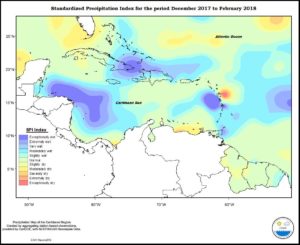 Apart from in Guadeloupe that ranged from moderately wet to moderately dry, rainfall in the eastern Caribbean islands was normal to above normal for the three month period. Trinidad ranged from slightly wet in the west to very wet in the east; Tobago very to extremely wet; Grenada, Barbados and St. Lucia moderately wet; Martinique from normal to the north to exceptionally wet in the south; Dominica exceptionally wet; Antigua and St. Maarten normal; and St. Kitts normal to slightly wet. Conditions in the Guianas ranged from slightly dry in western and central Guyana and western Suriname to moderately wet in eastern French Guiana. Aruba was normal to slightly dry, but Curacao normal to slightly wet. Puerto Rico was predominantly normal apart from the northeast that was slightly to moderately wet. Conditions in Hispaniola ranged from normal in the south to extremely wet in the north. Jamaica was predominantly moderately wet apart from the extreme west that was slightly wet, but Grand Cayman was normal. Conditions in Cuba ranged from slightly dry in the west to exceptionally wet in the east, while northern Bahamas ranged from slightly dry to normal. Conditions in Belize ranged from extremely wet in the west to normal in the north and south.
Apart from in Guadeloupe that ranged from moderately wet to moderately dry, rainfall in the eastern Caribbean islands was normal to above normal for the three month period. Trinidad ranged from slightly wet in the west to very wet in the east; Tobago very to extremely wet; Grenada, Barbados and St. Lucia moderately wet; Martinique from normal to the north to exceptionally wet in the south; Dominica exceptionally wet; Antigua and St. Maarten normal; and St. Kitts normal to slightly wet. Conditions in the Guianas ranged from slightly dry in western and central Guyana and western Suriname to moderately wet in eastern French Guiana. Aruba was normal to slightly dry, but Curacao normal to slightly wet. Puerto Rico was predominantly normal apart from the northeast that was slightly to moderately wet. Conditions in Hispaniola ranged from normal in the south to extremely wet in the north. Jamaica was predominantly moderately wet apart from the extreme west that was slightly wet, but Grand Cayman was normal. Conditions in Cuba ranged from slightly dry in the west to exceptionally wet in the east, while northern Bahamas ranged from slightly dry to normal. Conditions in Belize ranged from extremely wet in the west to normal in the north and south.
September 2017 to February 2018
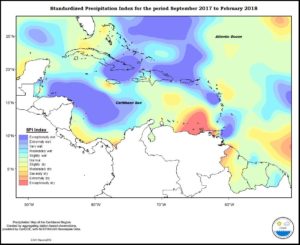 For the six month period, the rainfall in the eastern Caribbean was predominantly normal to above normal. Trinidad was slightly dry to exceptionally wet from west to east; Tobago moderate to extremely wet; Grenada moderately wet; Barbados extremely wet; St. Lucia normal to slightly wet; Martinique moderately dry to slightly wet from north to south; Dominica exceptionally wet; Guadeloupe extremely wet in the west to slightly wet in the east; Antigua normal; and St. Kitts normal to slightly wet. Conditions in the Guianas ranged from extremely dry in northwestern Guyana to moderately wet in northern Suriname and eastern and southeastern French Guiana. Aruba was slightly dry, but Curacao normal. Puerto Rico was exceptionally wet. Conditions in Hispaniola ranged from normal in the south to exceptionally wet in northern and eastern Dominican Republic, while in Jamaica they ranged from moderately dry in the southwest to extremely wet in the north. Grand Cayman was moderately wet. Cuba ranged from moderately dry in west central areas to exceptionally wet in the east, but northern Bahamas normal to moderately dry. Conditions in Belize ranged from normal in the east to moderately wet in the west and south and extremely wet in the north.
For the six month period, the rainfall in the eastern Caribbean was predominantly normal to above normal. Trinidad was slightly dry to exceptionally wet from west to east; Tobago moderate to extremely wet; Grenada moderately wet; Barbados extremely wet; St. Lucia normal to slightly wet; Martinique moderately dry to slightly wet from north to south; Dominica exceptionally wet; Guadeloupe extremely wet in the west to slightly wet in the east; Antigua normal; and St. Kitts normal to slightly wet. Conditions in the Guianas ranged from extremely dry in northwestern Guyana to moderately wet in northern Suriname and eastern and southeastern French Guiana. Aruba was slightly dry, but Curacao normal. Puerto Rico was exceptionally wet. Conditions in Hispaniola ranged from normal in the south to exceptionally wet in northern and eastern Dominican Republic, while in Jamaica they ranged from moderately dry in the southwest to extremely wet in the north. Grand Cayman was moderately wet. Cuba ranged from moderately dry in west central areas to exceptionally wet in the east, but northern Bahamas normal to moderately dry. Conditions in Belize ranged from normal in the east to moderately wet in the west and south and extremely wet in the north.
March 2017 to February 2018
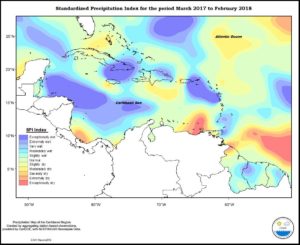 Rainfall was normal to above normal in the islands of the eastern Caribbean over the twelve month period. Trinidad ranged from normal in the west to extremely wet in the east; Tobago slight to moderately wet; Grenada moderate to very wet; Barbados and St. Kitts moderately wet; St. Lucia normal to slightly wet; Martinique slightly dry to slightly wet; Dominica exceptionally wet; Guadeloupe exceptionally wet to the west to moderately wet in the east; and Antigua normal. Rainfall in the Guianas was predominantly normal to above normal (being extremely wet in northern Guyana/Suriname border areas) apart from a portion of northern Guyana. Aruba was slightly dry, but Curacao normal. Conditions in Puerto Rico ranged from severely dry in the west to exceptionally wet in the east, while in Hispaniola they ranged from normal in the south to extremely wet in the northeast. Jamaica was slightly dry in the south to exceptionally wet in the north, but Grand Cayman was normal. Conditions in Cuba ranged from slightly dry in west central areas to exceptionally wet in the east. Northern Bahamas was normal to moderately dry. Conditions in Belize ranged from normal in central areas to moderately wet in the north and south.
Rainfall was normal to above normal in the islands of the eastern Caribbean over the twelve month period. Trinidad ranged from normal in the west to extremely wet in the east; Tobago slight to moderately wet; Grenada moderate to very wet; Barbados and St. Kitts moderately wet; St. Lucia normal to slightly wet; Martinique slightly dry to slightly wet; Dominica exceptionally wet; Guadeloupe exceptionally wet to the west to moderately wet in the east; and Antigua normal. Rainfall in the Guianas was predominantly normal to above normal (being extremely wet in northern Guyana/Suriname border areas) apart from a portion of northern Guyana. Aruba was slightly dry, but Curacao normal. Conditions in Puerto Rico ranged from severely dry in the west to exceptionally wet in the east, while in Hispaniola they ranged from normal in the south to extremely wet in the northeast. Jamaica was slightly dry in the south to exceptionally wet in the north, but Grand Cayman was normal. Conditions in Cuba ranged from slightly dry in west central areas to exceptionally wet in the east. Northern Bahamas was normal to moderately dry. Conditions in Belize ranged from normal in central areas to moderately wet in the north and south.
March 2016 to February 2018
Disclaimer
The information contained herein is provided with the understanding that The Caribbean Institute for Meteorology and Hydrology makes no warranties, either expressed or implied, concerning the accuracy, completeness, reliability, or suitability of the Outlook. The information may be used freely by the public with appropriate acknowledgement of its source, but shall not be modified in content and then presented as original material.
The Caribbean Regional Climate Centre
Caribbean Institute for Meteorology and Hydrology
Husbands
St. James
Barbados BB23006
CONTACT US
P.O. Box 130
Bridgetown
Barbados
Tel : +1 (246) 425 1362/3
Fax: +1 (246) 424 4733
Email: rcc@cimh.edu.bb

